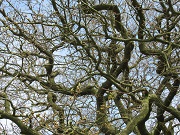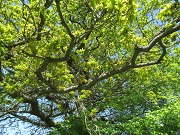A Branch of Life - continued

A person who has looked at this closely is Aljos Farjon, a botanist at the Royal Botanic Gardens, Kew.
Farjon’s study revealed that the types of land most favoured by oak were abundant in England from the Middle Ages, whereas in Europe the former ‘wood pasture’ had been converted into plantations. Land management practices in England also favoured the oak, enabling them to grow old. The word ‘forest’ has changed its meaning over time. It originally meant a place that was set aside by the Monarchs and noblemen for deer hunting. In Europe, similar areas had been converted and no longer could support ageing oak but in England the ‘Forests’ endured and the oak grew old. The passion in Britain for hunting served further to protect the land favoured by the oak. There were over 3000 deer parks in England, offering ideal conditions of light and space, for the oak trees to flourish and grow old. Many of the parks, and their trees, survive today.
“Despite great losses, private landownership preserved many of the ancient parks in England. On the continent it came too late. You will not find a single ancient oak in the Forêt d’Orléans, which is both older and larger than the New Forest. Private owners in England mostly declined offers to convert their parks into plantations and were more interested in pheasant shooting.

The ancient oaks in England are either pedunculate oak, Quercus robur, or sessile oak, Q. petraea, or their hybrids. I have visited many important sites, as well as all 115 living oaks in England with a girth over nine metres and recorded more than 600 ancient oaks. For each oak with a girth greater than six metres I tried to determine land use prior to 1603, the end of the Tudor dynasty. An oak of six metres girth is, on average, about 400 years old, while the larger ones (up to 14.02 metres in England) are likely older. Out of 3,433 oaks it was possible to determine past land use for 95%, albeit sometimes by inference and not with certainty. Of all the oaks older than 400 years, around 50% are associated with ancient deer parks. Some 12% were/are in royal forests or chases, 6.5% on wooded commons, and around 20% on a manor that did not have a deer park. Hedgerow oaks are common, but rarely this big. Their large oaks have usually disappeared where there was no prohibition or restriction to cut them, to be supplanted (or not) by younger trees. Only in recent times have these been allowed to grow big and, if left, will eventually become old.” Aljos Farjon – RBG Kew
The ancient oak tree plays an important role in the ecosystem, supporting more biodiversity than any other tree in the UK. It has always been known that the oak tree supported a lot of other species but recent work has found there are 2300 species associated with the oak, hundreds of which are only found on the oak and hundreds more that are rarely found anywhere else but on the oak.
“Recent work has used existing data sources to collate and produce the most comprehensive list yet of all species known to use oak trees (Quercus petraea and Q. robur) in the UK. In total 2300 species were listed; this consisted of 38 bird species, 229 bryophytes, 108 fungi, 1178 invertebrates, 716 lichens and 31 mammals. Bacteria and other micro-organisms that are associated with oak were not included, so the true number of species that use oak trees, although unknown, is much greater.
Of these 2300 species, 326 were obligate species (found only on oak) consisting of 57 fungi, 257 invertebrates and 12 lichens. Examples of such obligate species include the moths oak lutestring, great oak beauty and oak nycteoline; the fungi oak polypore, oak leaf blister and oak mildew and the lichens Arthonia byssacea, Calicium adspersum, Sclerophora farinacea. There were 229 species classified as highly associated with oak (rarely found on other tree species) consisting of 51 fungi, 104 invertebrates and 74 lichens - for example the oak leaf-roller, cobweb and twig cutter beetles. These 555 species were considered most at risk from a decline in oak health as they don’t or rarely use other tree species.” Dr Ruth Mitchell - plant and soil ecologist at The James Hutton Institute, Aberdeen
The acknowledgment of the importance the ancient oak plays, has put it on the agenda for almost all landowners. The preservation of what exists and establishing better legal protections is one step, but another step is to work with land management in establishing long term plans, which will bring about protected environments where the new oaks can find a place to grow old - thereby maintaining a rich environment for future generations of all associated life, far into the future.







